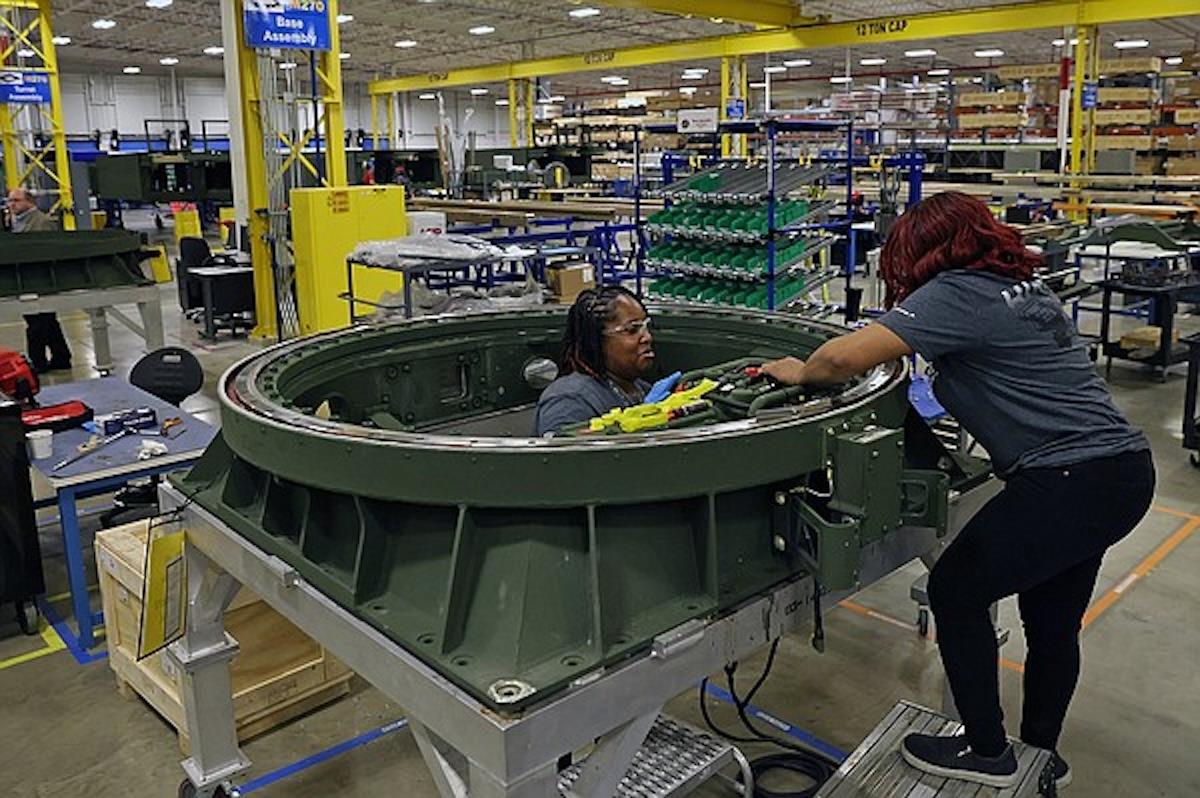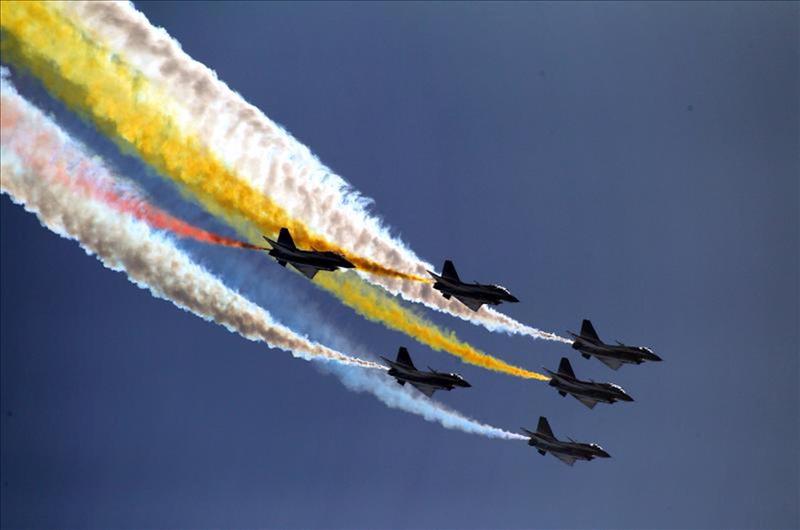Manned Fighters Still Rule In US-China Battle For Air Supremacy
This month, multiple media sources reported that China's People's Liberation Army Air Force (PLAAF) has reached a significant milestone by fielding at least 300 Chengdu J-20 stealth fighters, underscoring its accelerating buildup of fifth-generation combat aircraft.
The confirmation came as four J-20s, including the 300th production airframe identified by its construction number“CB10300,” arrived in Changchun, Jilin province, for an air show in mid-September.
Analysts noted the PLAAF has added at least 50 new aircraft since June 2024, reflecting a rapid delivery pace that places China second only to the US in operational stealth fleets.
The J-20 fleet now rivals the scale of the US Air Force's 180 F-22 Raptors and more than 240 F-35As, though the US total remains larger when US Marine Corps and US Navy aircraft are included.
The J-20's expansion illustrates China's strategy of mass-producing modern platforms to contest US air dominance in Asia, with the program evolving from a developmental project less than a decade ago into the backbone of China's airpower.
The US is not to be outdone. The War Zone (TWZ) reporte this month that Lockheed Martin is urging the US Air Force to expand its F-22 Raptor upgrade program to include 35 older Block 20 jets currently used for training, aiming to bolster combat readiness amid uncertainty over the aircraft's replacement timeline.
Skunk Works Vice President OJ Sanchez emphasized the strategic value of modernizing these sidelined aircraft at the recent Air, Space & Cyber Conference in Maryland. The push follows US Congressional pressure and operational concerns, as the US Air Force lacks a definitive successor to the F-22. Upgrades would extend viability into the 2040s, enhancing stealth, sensors and crewed-uncrewed teaming capabilities.
Latest stories
South Korea's strategic crossroads

How India can salvage its Trump trade deal

Startups can help restore the stagnant US defense industrial base
Highlighting that point, TWZ states that F-22s may be the first US aircraft to lead the Collaborative Combat Aircraft (CCA), with the combat-ready fleet set to receive the necessary tablets and supporting hardware to operate the latter, as the Next Generation Air Dominance (NGAD) program advances.
Furthermore, the US has begun production of the F-47, its first sixth-generation fighter jet, with the aircraft expected to make its maiden flight in 2028, according to US Air Force Chief of Staff General David Allvin, who announced this at the Air, Space, and Cyber Conference.
Built by Boeing under the NGAD program to replace the F-22, the tailless design fighter will feature enhanced stealth, hypersonic weapons capability, AI, quantum computing and integration with unmanned drones.
Allvin said prototypes had secretly flown since 2019 and stressed the urgency of delivery, while US Air Force Secretary Frank Kendall dismissed China's ability to extract intelligence from the released images.
The announcement comes weeks after China unveiled new J-15 variants and its J-35 stealth fighter during its September Victory Day Parade, amid reports it is also developing sixth-generation designs .
While both nations are investing resources in unmanned systems, the push to upgrade manned fighters highlights the limitations of drones and the enduring need for pilots in a Pacific conflict.
Voicing possible US concerns about unmanned technology, Jay Stout argues in a July 2025 Proceedings article that its unmanned loyal wingman drones face significant hurdles in terms of cost, survivability and AI.
He points out that building unmanned aircraft with manned-fighter performance makes them as expensive as crewed jets , while still being dependent on fragile communications and vulnerable to Chinese cyberwarfare.
Likewise, Eleanor Harvey and Timothy Ditter note in a May 2025 CNA article that Chinese experts worry their own unmanned aerial vehicles (UAVs) suffer from datalink fragility, sensor unreliability and tactical inflexibility, making them vulnerable to jamming and deception.
From this comparison, the US's problems with unmanned technology stem from prohibitive costs and overpromised capabilities. In contrast, China faces challenges related to technological immaturity and operational vulnerabilities.
Rohith Stambamkadi states in a February 2025 article for the Institute for Security and Development Policy (ISDP) that, despite their growing role on the battlefield, drones alone cannot attain air superiority due to fundamental limitations in adaptability, offensive capacity and survivability.
Stambamkadi observes that their reliance on static algorithms and sensor inputs hampers real-time decision-making in highly dynamic combat zones.
Stambamkadi notes that, unlike manned aircraft, drones lack endurance, which limits their effectiveness in contested airspace. He mentions that even stealth upgrades face countermeasures from AI-enabled multi-static radars.
Moreover, he states that stand-off-centric drone strategies risk ceding the initiative, as conflicts in Ukraine and Israel have shown that drones are easily neutralized when used in large numbers.
Given these caveats, both the US and China have explored manned-unmanned teaming (MUM-T) concepts to compensate for the shortcomings of manned and unmanned platforms.

Sign up for one of our free newsletters
-
The Daily Report
Start your day right with Asia Times' top stories
AT Weekly Report
A weekly roundup of Asia Times' most-read stories
In an August 2025 RAND report , Shanshan Mei notes that China views MUM-T as central to future combat but emphasizes augmentation over autonomy, focusing on software and algorithmic advances to support manned platforms while preserving strict Chinese Communist Party (CCP) control over wartime decision-making.
By contrast, Bryan Clark and Dan Patt argue in a September 2025 Hudson Institute (HI) report that the US concepts, such as CCA and“edge–pulse–core” force design, aim to use uncrewed systems as hedge forces that absorb risk, deny adversaries freedom of action and create openings for crewed aircraft to exploit.
In the expansive missile-threatened airspace of the Pacific, the key lesson is that crewed fighters should remain the on-scene leaders, while unmanned teammates extend their reach, take on risks and facilitate access.
Both the US and China are moving towards concepts where pilots control UAVs remotely, outside weapons-engagement zones, with drones“kicking in the door” through electronic warfare, deception, sheer numbers and extended targeting ranges, emphasizing the ongoing importance of human pilots for judgment and adaptive control.
Loyal wingmen that match fighter range, survivability and sensors won't be cheap, and their AI/datalinks are prime targets-making pilots the indispensable integrators, with drones adding attritable mass and tempo.
Pacific air dominance may thus hinge less on the number of drones than on which side better uses manned fighters to command swarms and seize the initiative when algorithms falter.
Sign up here to comment on Asia Times stories Or Sign in to an existing accoun
Thank you for registering!
An account was already registered with this email. Please check your inbox for an authentication link.
-
Click to share on X (Opens in new window)
X
Click to share on LinkedIn (Opens in new window)
LinkedIn
Click to share on Facebook (Opens in new window)
Facebook
Click to share on WhatsApp (Opens in new window)
WhatsApp
Click to share on Reddit (Opens in new window)
Reddit
Click to email a link to a friend (Opens in new window)
Email
Click to print (Opens in new window)
Print

Legal Disclaimer:
MENAFN provides the
information “as is” without warranty of any kind. We do not accept
any responsibility or liability for the accuracy, content, images,
videos, licenses, completeness, legality, or reliability of the information
contained in this article. If you have any complaints or copyright
issues related to this article, kindly contact the provider above.
Most popular stories
Market Research

- New Cryptocurrency Mutuum Finance (MUTM) Raises $15.8M As Phase 6 Reaches 40%
- Bydfi Joins Korea Blockchain Week 2025 (KBW2025): Deepening Web3 Engagement
- Yield Basis Nears Mainnet Launch As Curve DAO Votes On Crvusd Proposal
- 0G Labs Launches Aristotle Mainnet With Largest Day-One Ecosystem For Decentralized AI
- Ethereum-Based Defi Crypto Mutuum Finance (MUTM) Raises Over $16 Million With More Than 720M Tokens Sold
- Fintech's Gender Gap In Focus: Drofa Comms' Women Leading The Way Joins Evolvh3r's She Connects At TOKEN2049






















Comments
No comment